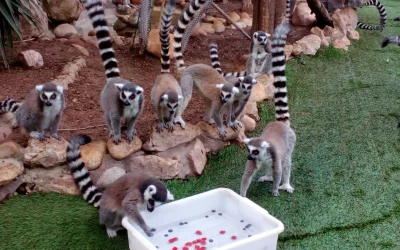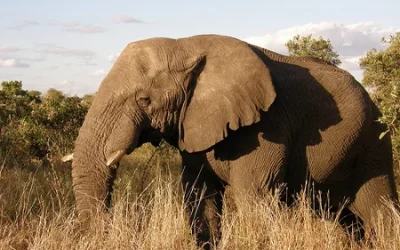M. Salas, X. Manteca
DIFFERENCES AMONG SPECIES
There are significant differences among species in their ability to adapt to captivity. Some species breed well in captivity and usually show no apparent signs of poor welfare, while other highly similar species sometimes live only a short time, breed little or not at all and often show abnormal behaviours.
Marine mammals provide several examples of these differences. Thus, the life expectancy of bottlenose dolphins (Tursiops truncatus) in captivity is similar to that of their conspecifics in the wild, and the rate of reproduction of this species may be even higher in captivity than in the wild. By contrast, other species of toothed cetaceans such as Fraser’s dolphin (Lagenodelphis hosei) and Dall’s porpoise (Phocoenoides dalli) are extraordinarily difficult to keep in captivity.
Among pinnipeds, walruses (Odobenus rosmarus) breed poorly and have a low life expectancy in captivity, and frequently show oral stereotypes. At the other extreme, gray seals (Halichoerus grypus) breed well in captivity and have a life expectancy equivalent to that of their counterparts in the wild.
These differences among species are important because they allow us to anticipate problems and predict which animals are more susceptible to the potential negative effects of captivity. Moreover, understanding the mechanisms that explain these differences would be very useful in the design of strategies to improve the welfare of wild animals in captivity.
Despite its importance, the study of differences in the ability of species to adapt to captivity is not exempt from methodological problems. If we use as a criterion of adaptation to captivity the average life expectancy, for example, we will have to take into account that the differences between two species could be due to a better ability of one species to adapt to captivity than the other species, or due to that one species has, in itself, a longer life expectancy than the other. This is reason why we have to express the average life expectancy of each species in captivity in relation to their life expectancy in natural conditions.
A second methodological problem is that not all species show the same signs of poor welfare. Therefore, before concluding that a species adapts better than another, we must ensure that we have evaluated several indicators or we have chosen an indicator that is equally relevant to both species.
Despite these difficulties, several studies have rigorously compared the adaptation to captivity of several species (see Table). The results of these studies as well as the observations of caregivers and veterinarians suggest the following considerations:
- Special attention is often provided to the welfare of some species that have specially developed cognitive capabilities because there are some reasons for thinking that the species with greater cognitive development may be particularly susceptible to the negative effects of captivity. However, it is important to remember that there are many species with a cognitive development similar in some aspects to those species considered ‘smarter’.
- Regardless of cognitive development, there are many other features that explain the differences between species in their ability to adapt to captivity. It is also possible that these characteristics vary according to the taxonomic group being considered. Examples of these features are the average distance travelled daily in carnivores or characteristics of the diet of ruminants.
- Finally, a factor which probably is very important in explaining some of the differences between species is the extent to which their biology is known.
However, there are still many questions about the differences between species in their ability to adapt to captivity.
| Taxonomic group | Number of species | Welfare indicators used | Results |
| Order Carnivorous | 33 | · Stereotypies
· Mortality rate of offspring |
Species that travel longer distances daily are less well adapted to captivity1. |
| Suborder Ruminantia | 78 | · Ratio of average life expectancy in captivity to maximum longevity | Species that are browsers and those for which there are no management guidelines are less well adapted to captivity2. |
| Order Psittaciformes | 53 | · Self-pecking
· Stereotypies · Reproduction |
More “intelligent” species, those that spend more time foraging in natural conditions, those that are more endangered and those that are more specialised in their ecological requirements are less well adapted to captivity3. |
DIFFERENCES AMONG INDIVIDUALS
The behavioural differences between individuals of the same species that are not attributable to age or sex, and that are consistent over time, are described with the terms ‘temperament’ and ‘personality’. Temperament is the result of the interaction of genetic and environmental factors, and among the last ones is especially important the environment where the animal is during the first stages of its development, including the stages previous its birth.
Scientists who study behaviour in animals have traditionally paid more attention to the similarities between individuals of the same species than to their differences. In recent years, however, numerous studies have been published on animal temperament in both mammals and birds and other vertebrate groups, and even some invertebrates. This interest is largely because temperament or personality is closely related to animal welfare. Indeed, the characteristics of animals’ temperament that are most frequently evaluated are fear, aggression and sociability, and they all have a very pronounced effect on welfare.
There are two ways to study the temperament of animals. A first method is for caregivers, or others who are very familiar with the animals under study, to award each animal a score for one or more previously defined characteristics of temperament. The other option is to record the frequency, duration or intensity of various behaviours that supposedly reflect the personality of the animals. The first method is less objective than the second, but in return can sometimes provide information that otherwise would not be recorded. Most studies on the temperament of zoo animals have been performed using the first method.
The assessment of the temperament of zoo animals has many practical applications. It has been demonstrated in several species that individual temperament allows us to forecast their reproductive success. For example, more fearful cheetahs (Acinonyx jubatus) reproduce less effectively than quieter individuals. A similar relationship between shyness and reproductive success was described in the giant panda (Ailuropoda melanolueca): the shyest females showed a lower frequency of sexual behaviours. The study on the relationship between temperament and breeding in the giant panda has identified the environmental factors that have a more pronounced effect on personality and therefore on breeding. In the black rhinoceros (Diceros bicornis), less dominant males have higher reproductive success than the most dominant. Moreover, large installations result in less dominant and aggressive males, and couples formed by a dominant female and a less dominant male are those with greater reproductive success.
Temperament is also important when you want to form stable groups of animals: the temperament of gorillas (Gorilla gorilla), for example, predicts aggressive and affiliative behaviour.
The response of animals to environmental enrichment programs depends on their temperament: while a new stimulus can stimulate exploratory behaviour and have a positive effect on the welfare of a non-fearful individual, the same stimulus can have the opposite effect in a very fearful animal. Finally, there is some evidence that seems to suggest that the temperament of the animal determines its susceptibility to certain diseases.
REFERENCES
- Carlstead K, Mellen J and Kleiman DG (1999) Black rhinoceros (Diceros bicornis) in US zoos: I. Individual behavior profil·les and their relationship to breeding succés. Zoo Biology 18: 17-34.
- Cavigelli SA (2005) Animal personality and Health. Behaviour 142: 1223-1244
- Clubb R and Mason G (2007) Natural behavioural biology as a risk factor in carnivore welfare: how understanding species differences could help zoos readesign enclosures. Applied Animal Behaviour Science 102: 303-328.
- Gosling SD and John OP (1999) Personality dimensions in non-human animals: a cross-species review. Current Directions in Psychological Sciences 8: 69-75.
- Mason GJ (2010) Species difference in response to captivity: stress, welfare and the comparative method. Trends in Ecology and Evolution 25: 713-721.
- Mcdonald Kinkaid H, Van Zeeland Y, Schoemaker N, Kinkaid M and Mason G (2014) Risk factors for poor welfare in Psittaciformes: do intelligence and foraging behaviour predict vulnerable parrot species? Proceedings of the 48th Congress of the International Society for Applied Ethology, Vitoria-Gasteiz.
- Müller DWH Lackey LB, Streich WJ, Fickel J, Hatt JM and Clauss M (2011) Mating System, feeding type and ex situ conservation effort determine life expectancy in captive ruminants. Proceedings of the Royal Society B 278: 2076-2080.
- Powell D, Lin H, Carlstead K, Kleiman DG, Zhang H-M, Zhang G-Q, Yu J-Q, Zhang J-G, Lu Y-P, Timothy SKN, Tang J and Snyder R (2008) Relationships between temperament, husbandry, mamagement and socio-sexual behavior in captive male and female giant pandes Ailuropoda melanoleuca. Acta Zoologica Sinica 54: 169-175.
- Tetley CL and O’Hara SJ (2012) Rating of animal personality as a tool for improving the breeding, management and welfare of zoo animals. Animal Welfare 21: 463-476.
- Whitham JC and Wielebnowski N (2009) Animal-based welfare monitoring: using keeper ratings as an assessment tool. Zoo Biology 28: 545-560.
- Wielebnowski NC (1999) Behavioral differences as predictors of breeding status in captive cheetahs. Zoo Biology 18: 335-349.



